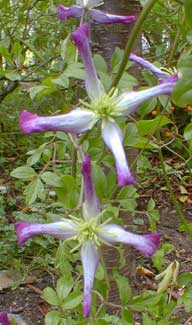
'Triternata Rubromarginata'
Flammula Group Dwarf Clematis
"It is forbidden to live in a town which has no garden or greenery."
-Jerusalem Talmud,
Kiddushin 4:12; 66d
Kiddushin 4:12; 66d
Clematis x triternata 'Rubromarginata' is an heirloom hybrid of C. flammula with C. viticilla 'Rubra.' It's a recipient of the Award of Garden Merit from the Royal Horticulatural Society. It was introduced in 1862 by Thomas Cripps of Tunbridge Wells, England.
It's small one & a half or two-inch blossoms are in full sway by mid-July & sometimes start in June. It has an extended blossoming time that can last until September. The blooms have a mild almondy vanilla scent. It blooms on new growth & the previous years vines will be dried out.
The dried vines should be hard-pruned toward the end of winter (February/March) to encourage rapid new growth in spring. Alternatively it can be moderately pruned late in autumn.
The bicolor flowers have a wide white stripe on each petal flanked by deep violet-purple or wine-colored edges. Some are wine-colored mainly at the tips, but ours tends to look striped. The eye is prominant, with pale anthers. Each blossom has four slim petals, quite odd & appealing.
Also on ours the petals often remain rolled backwards lengthwise, rather like cigarette papers, but other of the blooms will unfold flat. It tends to bloom quite well both high & low along the vines, rather than just up at the top like most dwarf clematises. It can do quite well in a bit of shade but especially here in the Northwest prefers more sun, so long as its roots are shaded.
After being overwhelmed by the gigantic blooms of so many other types of clematis, the tininess of the 'Rubromarginata' flowers are miniature charmers of extreme contrast.
Ours is planted near the dripline of a 'Loder's White' rhododendron, & long after the giant white blooms of the rhody are gone, the little purple & white blossoms of 'Rubromarginata' add new color throughout the shrub. It continues climbing from the rhody into the branches of a hornbeam tree, & easily reaches fifteen feet or even higher. It could alternatively be grown as a creeping, flowering groundcover.